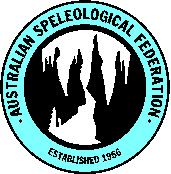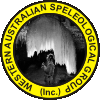
Summary of the Submission by the
Australian Speleological Federation (Inc)
on the Proposed Limestone Mine,
Quicklime Plant and Shiploading Facility Exmouth, WA
The Federation suggests that the environmental impacts at the proposed site are likely to be considerable and that an alternative site should be selected at the nearby Rough Range.
The Federation considers that a plan of action should be established for those instances where caves are intersected during mining activities. This plan should ensure that the resources of the intersected cave are fully qualified so that a qualitative decision whether to proceed can be made before mining of the cave commences.
The Federation recommends that a comprehensive quarry rehabilitation plan is produced prior to the granting of any mining approval.
Submission by the
Australian Speleological Federation (Inc)
on the Proposed Limestone Mine,
Quicklime Plant and Shiploading Facility Exmouth, WA
INTRODUCTION
The North West Cape peninsula is formed in Tertiary limestones. A coastal plain fringes Cape Range which is 311 m high, 16km wide, anticline of Miocene. The Trealla Limestone and most of the Quaternary deposits have been eroded off the top of the sequence, exposing the older Tulki Limestone and Mandu Limestone. The coastal plains consist predominantly of the shallow marine and aeolian Pleistocene Bundera Calcarinite.
This geomorphological description of Cape Range can be combined with the aesthetic one which shows the Range to be a beautiful series of colourful gorges and hills with intriguing limestone sculptures frequenting the surface limestone. Its visual tourist potential has barely been touched.
Beneath the surface Cape Range has produced 547 cave features with many more to be discovered as cavers more extensively explore the range.
WHAT IS THE ASF?
The Australian Speleological Federation (Inc) (ASF) comprises 27 corporate caving clubs and 20 associate caving clubs distributed throughout Australia. It is directed by a council headed by an executive. As well, the Federation has a number of Commissions that oversee Federation activities between meetings of the council and the executive.
The Conservation Commission of the ASF has four Co-Convenors who are strategically located across Australia to liaise with government departments, private land owners, or companies involved with the management of cave and limestone resources.
The ASF has provided consulting services relating to cave and limestone management to public and private cave managers throughout Australia. They have also assisted many cave managers in the identification of the cave resources with the limestone of their reserve, National Park or private land holding. This involves activities such as surveying caves, tagging cave entrances, or performing inventories of features within the cave.
The Federation has also been involved with four of Australia's most important karst conservation issues. The Mt Enta limestone mine in Queensland (for over 10 years), the Yessabah limestone mine in New South Wales (Keir Vaughn-Taylor 1991), the Lune River Quarry in Tasmania and the Sellicks Hill Quarry Cave (Buswell 1994) blasting and subsequent inquiry. In three of these cases mining has halted at each site and significant attempts have been made to preform restoration to parts of the quarries. In the case of Sellicks Hill mining of the cave has been halted while the inquiry has been in progress.
WHY IS CAPE RANGE SO IMPORTANT?
Besides its obvious aesthetic qualities the Cape has provided a wealth of information regarding Australia's past. The fossil records, the flora, the geology and the above ground and below ground fauna have all contributed to our extensive and increasing knowledge of our past.
The cave animals of Cape Range have only been studied extensively over the last decade(Grey 1989, Harvey 1988, Harvey 1991, Humphreys et al 1989, Humphreys 1993, Humphreys 1994). These studies by Museum staff in conjunction with members of ASF caving groups throughout Australia have shed new light on our links with Gondwanaland. A recent discovery in a water filled cave at Cape Range has been compared to finding a living dinosaur! This small aquatic animal has been living on earth since the time of the dinosaurs and was truly an exciting discovery.
LIMESTONE MINING AT CAPE RANGE
At present only a small quarrying operation for the extraction of limestone occurs on the Cape Range peninsula. However there is a very large temporary limestone mining lease (TR5980H) covering a significant area of Cape Range National Park and the pastoral lease of John LeFroy.
The Issues
Alternative Site at Rough Range.
The Federation believes that Whitecrest Enterprises has acted with considerable environmental concern in placing the proposed development outside of the current Cape Range National Park and its proposed extensions. However the Federation believes that the selected site also has the potential to:-
- encounter new caves in the mining process
- pollute the water table
- impact rare and endangered fauna
The Public Environmental Review document (PER) indicates that the Exmouth limestone resource is unique in Western Australia, being of a very high grade (> 97% CaCO3). However no comparative figures with other limestone deposits throughout Western Australia are provided. In particular the quality of the limestone from Rough Range to the south of Exmouth is not included in the PER.
It is the opinion of the ASF that the proposed limestone mining activity should be located at the nearby Rough Range which has shown good results of high quality limestone from test drilling.
To date no caves have been discovered on the Rough Range despite a number of visits to the range by speleologists. This area contains significant limestone resources that could be exploited without the need to quarry a known highly cavernous karst such as the Cape Range.
It is clear that the cost of the final product would be increased due to the extra transportation costs that would be incurred. However this increased cost must be evaluated with the following advantages taken into consideration:-
- that the integrity of the Cape Range karst would be maintained
- the significant potential for damage to the water table would be eliminated
- the significant potential impact on cave fauna would be eliminated
- the visual integrity of the vista from the National Park would be maintained
- the environmental sensitivity of WA mining companies could be conveyed to international visitors
- the potential destruction of caves would be greatly reduced
If the cost of production is found to be uneconomic due to this increased transportation costs then other alternative sites should be examined.
Major potential environmental impact
Some of the major environmental concerns of the Federation are:-
- The leaching of water used at the site into the water table
- The impact of water, carrying high sediment levels, on cave fauna and caves
- The Run-off of water into caves/cracks in the quarry.
- The potential pollution of the water table by blasting residues and spillage's.
- The potential destruction of unknown caves that do occur on the site
Water Usage
The proposed use of 55 m3 of water per day is a very low figure given the requirements of keeping dust levels low at the site and on the haulage road. Furthermore whatever water is used for this purpose will find its way into the groundwater carrying a quantity of the dust that has been suppressed. Such material will have detrimental effects on any terrestrial or subaquatic fauna is caves/cavities or in the water table beneath the proposed site.
Surface Water
The PER also indicates that extreme rainfall events do occur during cyclonic conditions. It is during these periods of severe rainfall that water will run-off the benches of the quarry into cracks and fissures carrying large quantities of dust and sediment into the underlying water table and/or caves.
Such heavy rainfall events in limestone quarries have already been shown to have dramatic impacts on cave fauna in underlying cave systems (Eberhard 1990 and 1992).
Pollution
The residues resulting from the blasting process are very likely to be carried into the water table and caves following the major rainfall events described above. This pollution is likely to have a significant impact on cave fauna as it will introduce a considerable level of foreign material to the cave systems and water table.
It has been shown that the terrestrial cave fauna are dependent for their energy primarily by the influx of organic matter washed into caves by intermittent run-off associated with heavy rain (Humphreys 1991). If the major energy input to the cave systems is accompanied by a considerable number of pollutants it is likely to have a major impact on the cave fauna.
Caves beneath the Proposed Site
At present no known caves, currently open to the surface, occur in the proposed Mining Lease M08/145. However it is highly likely that caves do occur within the mining lease. Curl (1966) indicates that in any highly cavernous karst, such as Cape Range, that the majority of cavities do not have an entrance that provides physical access by human beings to the caves below. Hence it is VERY likely (almost certain) that caves will be opened during the mining practise. This is further confirmed by the PER which indicated that cavities of between 0.2 to 0.6m in height were intersected at about 24-40m depth only 500m east of the proposed tenement. These passage heights are very common for horizontal cave development at Cape Range (e.g. Wanderers Delight 6km+ of surveyed passage with the majority at crawling height) and an extensive network of passages beneath the proposed tenement is very likely.
No management strategies are included in the PER to deal with the intersection of a cave passage. If the destruction of caves intersected during the mining process is to take place then the Federation requests that at least some appraisal of the cave should be undertaken prior to the mining of cave. In the case of the Sellicks Hill Quarry cave a very significant cave (by South Australian standards) was severely damaged by blasting before a complete appraisal could be made. This action by the mining company led to court action and parliamentary enquires which could have been avoided if standard procedures of full and proper appraisal were in place when new caves are intersected during the mining process.
Procedures to assess caves intersected during the mining process should be clearly detailed prior to the granting of a mining licence in any karst area.
These procedures should include the ability to conduct fauna surveys, cave inventories, surveys, photographic recording etc. These procedures should be undertaken depending on the extent and nature of the cave while taking into account the likely disruption to the mining process.
Visual Impact
Several references are made in the PER to the lack of visual impact because the proposed quarry would not been seen from the Exmouth townsite or from Murat Road. However the visual impact will be very high for tourists travelling the Shothole Canyon Road into the Cape Range National Park. This impact should be carefully considered as it will have a long term impact on the very important tourism industry.
Quarry Rehabilitation
Following the closure of the Lune River Quarry at Ida Bay in Tasmania considerable monies were spent on the attempted rehabilitation of the quarry site. No matter where the proposed Exmouth quarry is situated a rehabilitation plan, using the work conducted at Lune River (Gillieson 1995) as a guideline, should be developed. The rehabilitation plan outlined in the PER is considered inadequate.
REFERENCES
Buswell. C. (1994) Sellicks Hill Quarry Cave. Australian Caver 136: 18-23.
Curl, R.L. (1966). Caves as a measure of karst. J. Geol. 74 (6) :798-830.
Eberhard. S. (1990) The Cave Fauna at Ida Bay in Tasmania and the Effects of Quarry Operations, unpublished report to the Department of Parks, Wildlife and Heritage, Tasmania.
Eberhard. S. (1992) The effect of stream sedimentation on population densities of Hydobid molluscs in caves., Report to World Heritage Planning Team. Department of Parks, Wildlife & Heritage, Tasmania, 8pp.
Eberhard. S. (1995) The Cave Fauna at Ida Bay in Tasmania and the Effects of Quarry Operations, Proceedings of the 11th Conference of the Australasian Cave and Karst Management Association, Tasmania May 1995, in press.
Gillieson. D. (1995). Rehabilitation of the Lune River Quarry, Tasmanian Wilderness World Heritage Area, Australia. Australasian Cave and Karst Management Association Journal. 19: 4-10.
Grey, M.R. (1989). Cavernicolous spiders (Arancae) [sic] from Undara, Queensland and Cape Range, Western Australia. Helictite 27: 87-89
Harvey, M.S. (1988). A new troglobitic schizomid from Cape Range, Western Australia (Chelicerata:Schizomida). Records of the Western Australian Museum 14: 15-20.
Harvey, M.S. (1991). The cavernicolous pseudoscorpions (Chelicerata: Pseudoscorpionida) of Cape Range, Western Australia. Records of the Western Australian Museum 15: 487-502.
Humphreys, W.F. 1993. The significance of the subterranean fauna in biogeographical reconstruction: examples from Cape Range peninsula, Western Australia. In Humphreys W.F. (Ed) The Biogeography of Cape Range, Western Australia. Records of the Western Australian Museum 45: 165- 192.
Humphreys, W.F., Adams, M. and Vine, B. (1989). The biology of Schizomus vinei (Chelicerata:Schizomida) in the caves of Cape Range, Western Australia. Journal of Zoology, London. 217: 177-201
Humphreys, W.F. (1991). Biological research into the Cape Range karst area, North West Cape peninsula, Western Australia. Pp 6-14 in S. Brooks (ed.) Cave Leeuwin - Proceedings of the 18th Biennial Conference of the Australian Speleological Federation Inc., Margaret River, Western Australia. 30 December 1990 - 5 January 1991. Australian Speleological Federation, Broadway, New South Wales.
Humphreys, W.F. (1993). The significance of the subterranean fauna in biogeographical reconstruction: examples from Cape Range peninsula, Western Australia. In Humphreys W.F. (Ed) The Biogeography of Cape Range, Western Australia. Records of the Western Australian Museum 45: 165- 192.
Humphreys, W.F. (1994). The subterranean fauna of the Cape Range coastal plain, northwestern Australia. Unpublished report to the Australian Heritage Commission and the Western Australian Heritage Committee. 40pp
Vaughn-Taylor. K. (1991). What happened at Yessabah. Pp 108-113 in S. Brooks (ed.) Cave Leeuwin - Proceedings of the 18th Biennial Conference of the Australian Speleological Federation Inc., Margaret River, Western Australia. 30 December 1990 - 5 January 1991. Australian Speleological Federation, Broadway, New South Wales.

